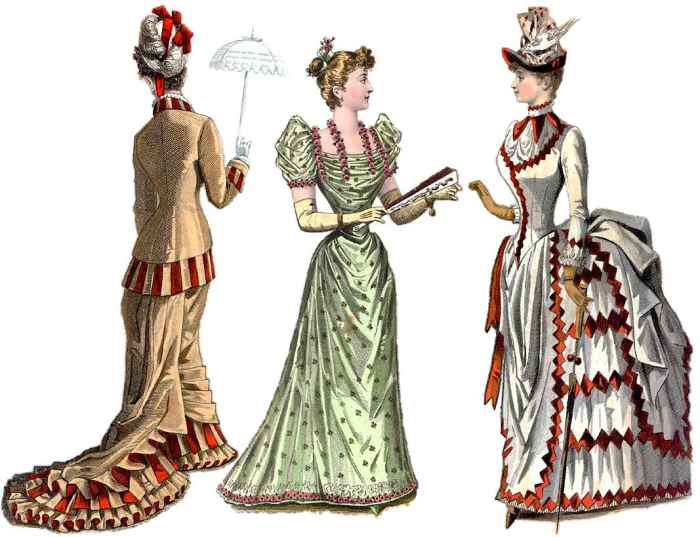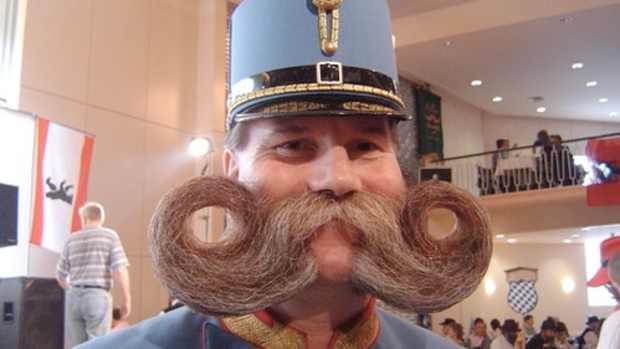Victorian Era Women's Fashions: From Hoop Skirts to Bustles

Victorian fashion plate: left is an early 1880s daywear dress; center is an 1880s evening dress; right is a mid-1880s day dress.
Uploaded by Churchh; wikimedia commons; Public Domaiin
Quick Facts About Victorian Fashion
- An hourglass silhouette was accentuated by tight corsets.
- Extreme styles introduced hoop skirts and bustles to fashion.
- The creation of synthetic dyes led to bright, wild colors.
- Highly ornamental fashions included ruffles, lace, and draping.
- The Aesthetic and Rational Dress movements questioned the dictate of fashion.
Victorian Clothing: Prim, Proper, and Outrageous
Despite the prim and proper feminine ideal of the time, fashions of the Victorian period created an often exaggerated, ostentatious look. Tight corsets, gigantic hoop skirts, and outrageous bustles make today's fashion trends look sedate by comparison.
Women usually wore high necked dresses that covered the upper chest and neck for daywear. Short sleeves and low cut bodices were reserved for evening with long sleeves worn during the day. In a time before sunscreen, women needed to protect their skin and did so with clothing as well as hats that shaded the face.
Clothing styles were dictated by propriety, and stylish garments were a sign of respectability. The copious amounts of fabric used in the creation of Victorian skirts usually meant that most women owned few outfits. Detachable collars and cuffs enabled a woman to change the look of a garment for a bit of variety. Of course, wealthier women owned more garments that were made of finer fabrics and used more material and embellishments.

Victorian riding habit circa 1847—in those days, women rode side saddle.
Uploaded by Churchh; Wikimedia Commons; Public Domain
The Victorian Period in Fashion: Historical Background
The Victorian period, generally the time between 1837 and the 1890s, is named after Britain's Queen Victoria (1819–1901), a long-lived and highly influential monarch in an era when women had little power or opportunity.
In those days, women lived at the largess of men; first their fathers or guardians, then their husbands. A young lady was expected to be meek and mild, to acquiesce to her father's or husband's wishes. A woman's intelligence and wit were restricted to social events and amusing conversation.
Jobs for Women
Employment opportunities were limited to teaching young girls, being a governess, domestic servitude, and later factory or mill work. Of course, rural women had plenty of work if they lived on a farm. Some women earned money from cottage industries, but the Industrial Revolution put an end to enterprises such as spinning yarn and making lace at home.
The Industrial Revolution
The Industrial Revolution created new wealth for investors, industrialists, and merchants. It introduced a new middle class who, proud of their status, displayed their wealth with great ostentation. Women wore their status in fabric, from the mid-century hoop skirts to the bustle later on in the beautiful dresses and styles of the Victorian period.
The Industrial Revolution created a new urbanization as towns and cities filled with workers for the new mills and factories where women worked long hours in grim, dirty, and often dangerous conditions.

Queen Victoria 1845 – Portrait by Franz Xaver Winterhalter
Uploaded by Krinkle;wikimedia commons; Public Domain
Early Victorian Fashion
1836 ushered in a new change from the Romantic style of dress. Large Gignot sleeves suddenly slimmed and a seam line dropped the shoulder of dresses. A tight-fitting bodice was boned and slanted to emphasize the waist. Cartridge pleats at the waist created volume in the skirt without adding bulk to the waist. Women of a higher social class were expected to be demure and indolent as reflected by the restrictive dropped shoulder lines and corsets.
- Dresses in soft colors could be refreshed with detachable white collars and cuffs.
- In the 1840s, extra flounces were added to skirts and women wore a short over-skirt in day dressing. Skirts widened as the hourglass silhouette became the popular look, and women took to wearing layers of petticoats. Bodices took on a V shape and the shoulder dropped more.
- Evening wear exposed the shoulders and neckline, and corsets lost their shoulder straps. Sleeves of ball gowns were usually short.
- Although women wore what we call "dresses," many of these costumes were actually a separate bodice and skirt.
- Three-quarter length sleeves lasted through most of the Victorian period and some sleeves began to sprout bell-shaped ruffles.
- For most of the 19th century, bonnets were the headgear of choice. Styles varied from plain to heavily ornamented.
Victorian Hair and Makeup
Women's hair was generally worn long, caught up in a chignon or bun. In the 1840s, ringlets of curls hung on either side of the head. In the 1870s, women drew up the side hair but let it hang in long, loose curls in the back. Crimping became popular in the early 1870s.
Throughout the Victorian period, women wore false hairpieces and extensions as well as artificial flowers such as velvet pansies and roses, false leaves, and beaded butterflies, often combined into intricate and beautiful headpieces.
Recommended
Makeup was mostly worn by theater people. The look for women in Victorian days was very pale skin, occasionally highlighted with a smidge of rouge on the cheeks.
The Victorian Corset
A corset is an undergarment set with strips of whalebone (actually whale baleen), later replaced by steel. Though criticized as unhealthy, and certainly uncomfortable, corsets were a fashion staple throughout the 19th century, granting women social status, respectability, and the idealized figure of youth. Often called "stays," from the French "estayer," meaning support. Corsets were thought to provide support to women, the weaker sex.
Critics, including some health professionals, believed that corsets caused cancer, anemia, birth defects, miscarriages, and damage to internal organs. The tight restriction of the body did deplete lung capacity and caused fainting.
The popular concept of an obsession with a tiny waist is probably exaggerated. The competition of cinching to improbable dimensions was more of a fetish or a fad and not the norm as depicted in the 1939 film Gone with the Wind when Scarlett O'Hara cinches her corset to a 17" waist.




Mid-Victorian Crinolines and Hoop Skirts
In the 1850s, the dome-shaped skirt switched to tapered skirts that flared at the waist. The new hourglass figure grew to exaggerated proportions. Layers of petticoats were suddenly not enough and the crinoline was introduced to add volume to skirts. Crinoline was a heavy, stiff fabric made of woven horsehair that was expensive and impossible to clean.
Hoop Skirts (Cage Crinolines)
In the 1850s, a cage-like affair replaced the multi-layered petticoats. Called hoop skirts, cage crinolines, or cages, they were lightweight, economical and more comfortable than the heavy crinolines. Cage crinolines, which produced the huge, voluminous skirts so often associated with mid-century Victorian fashion, were made of flexible sprung steel rings suspended from fabric tape.
The look was so popular and economical that lower-middle-class women, maids, and factory girls sported the style. Cheaper hoop skirts included a dozen hoops while the high-priced variety featured 20–40 hoops for a smoother line. The hoop industry grew large and two New York factories produced 3,000 to 4,000 hoop cages a day, employing thousands of workers.
Early versions of hoop skirts reached the floor, but hemlines rose in the 1860s. Sleeves were often tight at the top, opening at the bottom in a bell-like shape.




